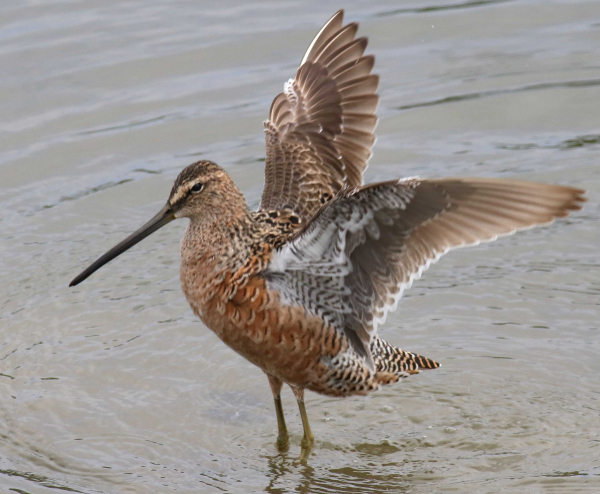
Hundreds of species of birds rely on the Coastal Plain of the Arctic National Wildlife Refuge, ranging from waterfowl and cranes to songbirds and shorebirds – a Long-billed Dowitcher among them.
|
Showing great concern for the Arctic Refuge and its importance to hundreds of species of birds as essential nesting and migration stopover habitat, on March 7 a total of 312 credentialed scientists, including many Arctic experts, sent a detailed letter to the U.S. Department of the Interior opposing oil and gas leasing in the Arctic National Wildlife Refuge. According to an Audubon article published this week, the scientists specifically identify a list of serious flaws in the Bureau of Land Management’s (BLM) Draft Environmental Impact Statement (DEIS) on the proposed oil leasing plan.
Stan Senner, National Audubon Society’s Vice President for Bird Conservation, Dr. John Schoen, Board Chair for Audubon Alaska and retired biologist with the Alaska Department of Fish and Game, and other Alaska experts have reviewed the DEIS in detail and have written a 10-point letter to the BLM identifying specific weaknesses in the agency’s data and assumptions that would have serious consequences for birds and other wildlife.
Among the letter’s 312 co-signers from 37 American states and including 73 scientists from Alaska, the Wildlife Conservation Society’s Dr. George Schaller said, “I did biological surveys in what is now the Arctic National Wildlife Refuge in 1952 and 1956 and again in 2006 and 2008. Having read the BLM draft environmental impact statement, I'm distressed and disconcerted by the lamentable lack of solid information about the potential impact of oil development on the landscape and on the flora and fauna. Where are recent data on trends in Caribou numbers, Polar Bears, and migratory bird species?”
Highlights from the letter are listed below:
1) The data supporting the Draft Environmental Impact Statement (DEIS) are inadequate, which means resource managers won’t be able to document, prevent, or later mitigate damage to the tundra and its wildlife. Missing basic information includes snow depths and drifting patterns, river flows, and hydrological systems, as well as, up-to-date surveys of wildlife populations including Tundra Swans, Polar Bears, Muskox, and Caribou.
2) The DEIS fails to account for the millions of gallons of water needed for drilling and building ice roads in assessing how oil development would impact the scarce water resources on the Arctic Refuge Coastal Plain. This includes springs, icings, lakes, rivers, streams, and coastal lagoons that support the unique plant and animal life.
3) The DEIS is unrealistic about keeping inside the 2,000 acre limit on the area to be covered by production and support infrastructure. It fails to include gravel mines, ice roads, and elevated pipelines that would support operations. It treats “reclaimed” areas as untouched, on the unsupported assumption that after it’s been trampled and drilled, this fragile landscape could actually return to its pristine state.
4 thru 10) In all, there are 10 important points in the letter, which can be accessed in full at https://ak.audubon.org/sites/g/files/amh551/f/arctic_nwr_leasing_science_letter_2019_03_07.pd
“The Arctic National Wildlife Refuge was an idea born of science – from scientists in Alaska who understood the importance of protecting this portion of the U.S. Arctic,” commented Audubon Alaska’s Executive Director, Dr. Natalie Dawson. “This letter is an incredible gathering of diverse voices from across today’s scientific community who still recognize the Refuge as a place worth protecting.”
The above Audubon article can be accessed at https://www.audubon.org/news/more-300-scientists-oppose-arctic-refuge-drilling-plan